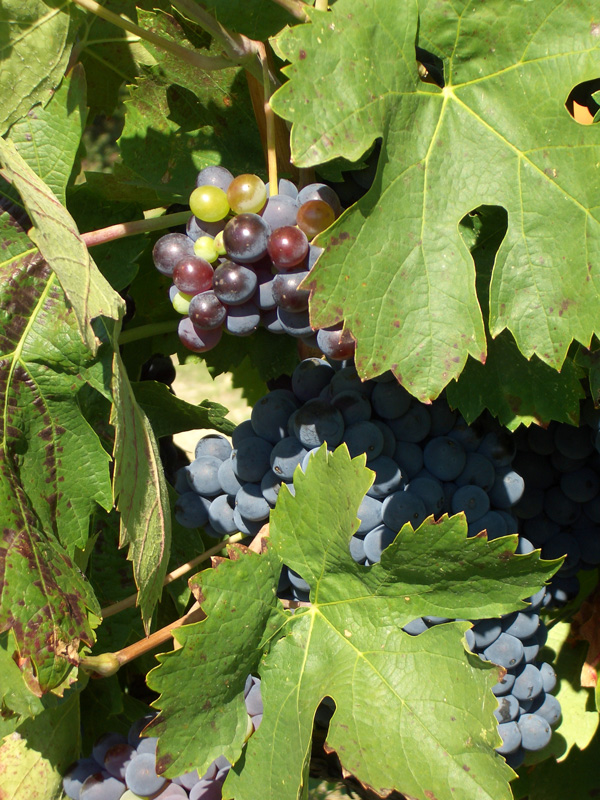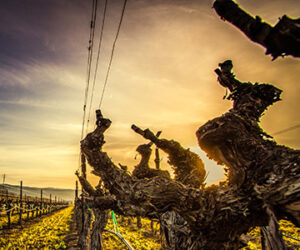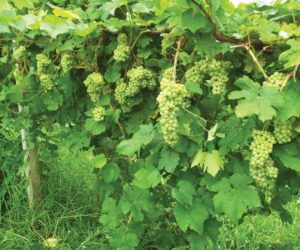Over the years I have presented readers with perspectives on some sixty individual grape varieties. Often, as I research the varieties that I write about in this column, I gain an inner perspective of any one of them that could be equated to the children’s story The Little Engine That Could. That was the story about an animated train locomotive that was called upon to pull a very long train over the mountain when all the other stronger engines would not step up to the task. I remember my mother reading aloud to me and telling me that the underlying message was that anyone can succeed in anything they set their mind to, or are asked to do. You just have to think strong. There are those king and queen grape varieties for which pulling that train over the mountain, or otherwise being made into wine, is easy. But many other grape varieties present the winemaker with new challenges that require the philosophy “I think I can, I think I can,” proceeding up the mountain, and then eventually over. Maybe it is just me, but Cinsault can be one of those challenges in the field and the cellar that will require a winemaker to have the same relentlessly positive attitude of the little engine. But don’t give up hope when faced with this grape, because it can be a rewarding and delicious wine to make if you can make it to the top of the mountain.

Cinsault, a red grape variety, has been described as “rather delicate but copes with heat or drought.” It is susceptible to fungal diseases such as Esca and Eutypa dieback. With Cinsault, the woody portions age quickly and build up resident fungal infections. Spores are released from these localized infections and then are introduced into the pruning wounds. Careful prevention of this at the time of pruning will help stave off these problems. To manage this, delay your pruning until later in the dormant season, or if you must prune, apply a protectant to the wound itself. But the delicateness doesn’t stop there. As the growing season progresses, it is found to be susceptible to mites and grape moths. While delicate in the field, when well-managed, growers will find it is a fertile producer and a drought-tolerant vine. It is late budding, making it less susceptible to spring frosts. It has a relatively short growing season, being a mid-ripening variety, but above all, it has big bunches with big berries.
Of note is that its home range is from the Languedoc-Roussillon and Provence-Côte d’Azur regions of France, where it has a long history dating back to the 1600s. The warm, dry soils of southern France have tended to produce bountiful crops, which in some seasons need to be curbed somewhat to maintain quality. But recent upward trends of temperatures in the south of France have the winegrowers balancing crop yields to help mitigate the higher sugars that are resulting in historically high-alcohol wines. They are lobbying their respective AOC governing bodies to permit leaving more fruit on the vine to prolong ripening and keep sugar levels down. But higher crop loads need to be balanced with the respective growing season so maturation, as opposed to sugar accumulation, occur simultaneously through the vineyard.
While delicate in the field, when well-managed, growers will find it is a fertile producer and a drought-tolerant vine.
Other places in the world where it is grown and produced into wine are Italy (under the name Ottavianello), Spain, Turkey, Lebanon, Morocco, Algeria, California, Washington State, and South Africa, where it was incorrectly named Hermitage and bred with Pinot Noir to produce Pinotage, one of South Africa’s most successful varieties. South Africa was home to two color mutations of Cinsault, one with grey berries and the other with white berries, but they seem to have disappeared and have been deleted as official variety designations. What I found most interesting in the literature was that when Algeria was constitutionally part of France, large volumes of Cinsault were imported into France to beef up the more “weedy Burgundies of the day.” I don’t know what “weedy” means, but today, Burgundian winemakers would have no part of the act of blending in Cinsault or the notion that their wines were of poor quality.
There are producers that make Cinsault into single varietal dry red wine styles, but most of them will incorporate it as a component in blends along with Grenache, Mourvèdre, Syrah, Mazuelo (Carignan), and Piquepoul. In California, the producers that identify themselves with the Rhone Rangers understand Cinsault as a blending component. But back to opening paragraph with the optimistic “I think I can” mantra, we find several winemakers who can shape this grape into nice versions of it as a varietal wine as well. The winemaker should look at the site and make the wine style that best suits the grape that results. Like the French, balancing crop load in California’s warm, dry climate is important, but we are fortunate to be able to ameliorate the potential high sugars by adding water to the must prior to fermentation if we were to hang the fruit longer for further color development. Not all climates permit the longer hang times.
What I really like about Cinsault is that its juicy berries with all that skin surface area are ideal to be made into rosé-style wines. In the south of France, rosé wines are more salmon color, which is typical of the region. My experience in home winemaking judging of Cinsault rosés in general is that they take on a more phenolic, albeit astringent sensation as a result of too much skin contact. One thing I have learned over the years is that the grape will give you what it wants to give you. Your maceration period is so important to give you color and character. Use of enzymes to help your color extraction can cut down on maceration times that can lead to excessive bitterness and astringency, all of which are going to overwhelm the fruitiness you want to achieve in making a rosé-style wine. In any variety that I am going to make a rosé, I limit the maceration time to 24 hours or less. I monitor the color every 4–6 hours and press when I feel I have the color that I want, but I will always press at 24 hours and accept what the grape has given me. If you don’t get the color you desire you can also blend in a little red later to boost your color. Some will turn to red juice concentrate to add a little sweetness.
Another important aspect of making Cinsault rosés is getting a good acid balance, which is crucial to mouthfeel. If it is too acidic, then that little bit of sweetness can help. The grapes I have obtained in the past were high in pH and low in acid, so I would supplement the must with tartaric acid prior to maceration to help protect it from spoilage. Once I pressed, I would taste or measure for the acid in the juice again to see if it needed additional supplement. Another advantage of getting the pH lowered during maceration is to extract more red colored pigments.
Cinsault’s popularity has declined somewhat. Some of the reasons being descriptions I have read of it as “light” and “unremarkable.” I have no doubt in these descriptions. If you have read my articles over the years, you know I am the biggest proponent of site matching the variety. Understand your growing conditions, and you will understand the wine being made from the grapes there. Remember, the best wines are made in the vineyard. While “light” and “unremarkable” may be true in some regions, the terms “outstanding,” “superb,” and “excellent” are descriptors in other regions. The wine style you choose to make it into also is important.
So this little engine closes out with one last description by Jancis Robinson — “an underrated Mediterranean-loving variety making characterful rosés and flirtatious reds.” So I conclude that some varieties are easy, and some aren’t, but with Cinsault I thought I could, I thought I could . . . and here it comes . . . I did! Enjoy!
Cinsault Rosé recipe (5 gallons/19 L)
Ingredients
125 pounds (57 kg) fresh Cinsault fruit
Distilled water
10% potassium metabisulfite (KMBS) solution (Weigh 10 grams of KMBS, dissolve into about 50 mL of distilled water. When completely dissolved, make up to 100 mL total with distilled water.)
5 g Lalvin 71B yeast (Red Star Premier Cuvee can be used as a substitute)
10 g Diammonium phosphate (DAP)
10 grams Fermaid K (or equivalent yeast nutrient)
Rice hulls
Dry ice
Other equipment or needs specific to this recipe
15-gallon (57-L) food-grade plastic bucket for fermentation
6-gallon (23-L) bucket
6-gallon (23-L) carboy
5-gallon (19-L) carboy
Racking hoses
Destemmer/crusher
Wine press
Inert gas — nitrogen, argon or carbon dioxide
Ability to maintain fermentation temperature at 55–60 °F (13–16 °C)
Thermometer capable of measuring between 40–110 °F (4–43 °C) in one degree increments
Pipettes with the ability to add in increments of 1 milliliter
Tartaric acid – addition rate is based on acid testing results
Step by step
- Clean and sanitize all your winemaking tools, supplies, and equipment.
- Crush and destem the grapes. Transfer the must to your 15-gallon (57-L) fermenter.
- During the transfer, add 15 mL of 10% KMBS solution (This addition is the equivalent of 50 ppm SO2).
- Layer the headspace with inert gas and monitor every 4–6 hours for color development. It will be time to press the must when rosé color is achieved. The maximum time you’ll want to leave on skins is 24 hours. Enzymes could be used to aid color extraction.
- Measure the volume of the must and stir in the rice hulls. The goal is 30% rice hulls in the slurry. The rice hulls aid in pressing by creating juice channels. Your juice yields will increase significantly with their use. For pressing, have dry ice chucks on hand. You’ll want to see visible gassing, viewed as “smoke,” bubbling when the must is pressed.
- Move the must/rice hull slurry directly to the press. Press to the 6-gallon (23-L) bucket. The dry ice chunks should be in the bucket.
- While pressing the juice to the bucket, add 8 milliliters of the 10% KMBS solution. This addition is the equivalent of 20 mg/L (ppm) SO2. Test the juice for acidity. Adjust as needed with tartaric acid. You’ll want to be around 6.5–7.5 g/L. Move the juice to the refrigerator.
- Let the juice settle at least overnight. Layer the headspace with inert gas or add dry ice and keep covered.
- When sufficiently settled, rack the juice off of the solids into the 6-gallon (23-L) carboy.
- Prepare yeast. Heat about 50 mL distilled water to 104 °F (42 °C). Sprinkle the yeast on the surface of the water and gently mix so that no clumps exist. Let sit for 15 minutes undisturbed. Measure the temperature of the yeast suspension. Measure the temperature of the juice. You do not want to add the yeast to your cool juice if the temperature of the yeast and the must temperature difference exceeds 15 °F (8 °C). To avoid temperature shock, acclimate your yeast by taking about 10 mL of the juice and adding it to the yeast suspension. Wait 15 minutes and measure the temperature again. Do this until you are within the specified temperature range. When the yeast is ready, add it to the fermenter.
- Add Fermaid K or equivalent yeast nutrient
- Initiate the fermentation at room temperature ~(65–68 °F/18–20 °C) and once fermentation is noticed, (~24 hours) move to a location where the temperature can be maintained at 55 °F (13 °C).
- Two days after fermentation starts, dissolve the DAP in as little distilled water required to completely go into solution (usually ~20 mL). Add the DAP solution directly to the carboy. Do not add the DAP crystals to the juice unless you want to re-create those volcano experiments from school.
- Normally you would monitor the progress of the fermentation by measuring Brix. One of the biggest problems with making rosé or white wines at home is maintaining a clean fermentation. Entering the carboy to measure the sugar is a prime way to infect the fermentation with undesirable microbes. So at this point, the presence of noticeable fermentation is good enough. If your airlock becomes dirty by foaming over, remove, clean and sanitize it, and replace as quickly and cleanly as possible.
- Leave alone until bubbles in the airlock are about one bubble per minute. Usually about two to three weeks.
- Measure the Brix. The wine is considered dry or nearly dry when it reaches -1.5 °Brix or less.
- When the fermentation is complete, add 3 mL of fresh KMBS (10%) solution per gallon (3.8 L) of wine.
- Transfer the wine off of the lees to the 5-gallon (19-L) carboy and lower the temperature to 38–40 °F (3–4 °C). Make sure there is no headspace. If you have leftover wine, you might as well have this for dinner.
- After two weeks, test for pH and SO2. Adjust as necessary to attain 0.8 ppm molecular SO2. (There is a simple SO2 calculator at www.winemakermag.com/guide/sulfite). Check the SO2 in another two weeks, prior to the next racking, and adjust while racking. HINT: Rack to another sanitized 5-gallon (19-L) carboy, or your bucket. In the case of the latter, clean the original carboy and transfer the wine back to it. This is done at about 4–6 weeks after the first SO2 addition. Once the free SO2 is adjusted, maintain at the target level by monitoring every 3–4 weeks.
- Consult the search section on our homepage for tips on fining and filtration.
- At about three months you are ready to bottle. Be sure to maintain sanitary conditions while bottling. Once bottled, you’ll need to periodically check your work by opening a bottle to enjoy with friends.







